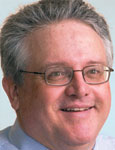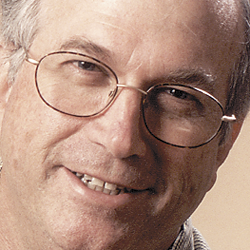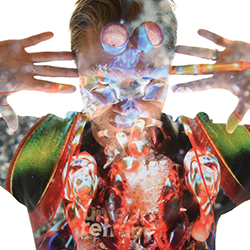 |
 Bob Milam
Bob Milam,
independent
industry consultant, is a former
EXHIBITOR Editorial Advisory
Board member and a past
All-Star Award winner, and a
current EXHIBITOR Conference advisory
board and faculty member.
tradeshowbob
@gmail.com
|
| |
 t a convenience-store show a few years back, I happened upon a booth for Playboy magazine. But who do you think I saw there signing autographs for the adoring masses? The girls from Hugh Hefner's reality show, or some buxom brunette - her turnons, walks on the beach and genuine smiles; her turnoffs, mean people and rainy days? Nope. Signing his name for the attendees was a short University of Notre Dame alum named Daniel Ruettiger, better known as "Rudy" - his nickname and the title of the eponymous sports movie made about his unlikely college football career as a player for the Fighting Irish. t a convenience-store show a few years back, I happened upon a booth for Playboy magazine. But who do you think I saw there signing autographs for the adoring masses? The girls from Hugh Hefner's reality show, or some buxom brunette - her turnons, walks on the beach and genuine smiles; her turnoffs, mean people and rainy days? Nope. Signing his name for the attendees was a short University of Notre Dame alum named Daniel Ruettiger, better known as "Rudy" - his nickname and the title of the eponymous sports movie made about his unlikely college football career as a player for the Fighting Irish.
Why were attendees treated to Rudy rather than Miss April or some other Bunny? While I don't know the defi nitive answer - I never asked the Playboy people - I do know this: No one thinks of Playboy and expects to see a short Catholic man from Notre Dame. My guess is, the Playboy folks had a certain budget, the Playmates were all busy doing something more important than signing their names for strangers, and Rudy cost the right amount of money.
Sure, one could argue that "Rudy" is a sports movie beloved by men, and men read Playboy. Still, for a magazine that positions itself as a postmodern guide for men, the connection is tenuous at best.
But what's the big crime? Rudy drew a good crowd. Mission accomplished, right? No, because when the show was over, busy attendees no doubt had a hard time connecting Rudy to the image of Playboy.
Random Rudy
Everything in your booth should be about telling attendees who you are, from the graphics on your back wall to the giveaways you're distributing. Whether you develop an overall booth theme that relates to your company or its key messages, or simply use images and incentives that reinforce your company's differentiators, the point is to avoid random elements that don't relate to your brand. And Rudy was about as random as they come.
Sadly, Playboy is not alone in its promotional randomness. This alarming disconnect between a company's traffic-building efforts and its brand identity is not uncommon. In fact, all you have to do is walk down the aisles of your next show to see at least a handful of exhibitors giving away iPods, or hosting in-booth putting greens - promotions that, unless the respective exhibitors sell golf balls or host online music-download services, have little to nothing to do with their companies or products.
And even if attendees remember the exhibitors for these generic traffic builders, they're more likely to be remembered as "the booth with the putting green" than "the company with the energy-efficient widgets."
Every company has an identity or a message it wants to convey to attendees. That message can, and should, be woven through all the elements of your exhibit, including giveaways and traffic stoppers. Then - and only then - are attendees likely to connect your promotion, or your giveaway, or even your graphics back to your brand.
For example, Blue Telescope Inc., a provider of interactive exhibit technologies with names such as Constellation and Star Map, created an outer-space theme to reinforce its brand identity, complete with a little alien mascot and an Area 51 vibe. Its giveaways also played on the theme: Milky Way candy bars, miniature playing cards with cartoon aliens, and little alien figurines.
Blue Telescope could have given away an iPod instead. It certainly would have been easier to go to the local Best Buy, pick one up, and hold a drawing than it was to brainstorm and execute an entire integrated marketing program. But I can almost guarantee you that no one forgot Blue Telescope two weeks or two months after seeing its booth, because the company created a cohesive exhibit experience where all of the elements made sense and worked together to reinforce the company's brand, its message, and its products.
Quit Copping Out
Adopting a generic giveaway or traffic building promotion is a lazy cop-out. In fact, I would contend that having no traffic builder at all is better than a generic traffic builder that doesn't do anything to communicate your key messages or help you achieve your objectives. In tough economic times, when budgets are tight, random elements aren't only ineffective, they're inefficient. Unless your objective is to attract attendees who love cheesy football films, Rudy is a waste of time, money, and booth space. Similarly, unless you're hoping to develop a pool of prospects who love free electronics, that iPod giveaway might not be the best fit for your program.
So instead of defaulting to the iPod, give attendees something that will remind them of your company. In fact, something inexpensive that can be given to multiple attendees - Blue Telescope hands out dozens of its themed goodie bags - is better than one unrelated and expensive prize, like an iPod, that only one person will take home.
At the Wisconsin Association of Meat Processors show a few years back, we created a contest where we asked attendees to guess what ingredients we'd put into our chili. Each attendee who took part in our contest took significant time to study the list of potential ingredients we'd given them to choose from as they sampled the chili. Of course, this meant they also studied our flavors as they made their guesses.
Sure, we could have hosted an in-booth putting green, and we might have even generated the same amount of traffic. But those attendees would have left our booth knowing little more than whether or not they can sink a long putt. Our on-target promotion didn't just attract attendees to the booth, it communicated who we are and what we do, and it coaxed booth visitors to spend time savoring our flavorings.
So remember, no matter who you are, you've got a story to tell or a message to deliver. Generic promotions aren't just a cop-out, they represent a missed opportunity to reinforce your brand, communicate your company's key messages, or draw attention to your products' differentiators. If you're looking to accomplish any of those objectives, identify and eliminate the random elements from your trade show program, and replace them with promotions and traffic builders that say something about your company and what it does. If, on the other hand, you're looking to improve your golf swing, the putting green is probably the way to go.e
|





 t a convenience-store show a few years back, I happened upon a booth for Playboy magazine. But who do you think I saw there signing autographs for the adoring masses? The girls from Hugh Hefner's reality show, or some buxom brunette - her turnons, walks on the beach and genuine smiles; her turnoffs, mean people and rainy days? Nope. Signing his name for the attendees was a short University of Notre Dame alum named Daniel Ruettiger, better known as "Rudy" - his nickname and the title of the eponymous sports movie made about his unlikely college football career as a player for the Fighting Irish.
t a convenience-store show a few years back, I happened upon a booth for Playboy magazine. But who do you think I saw there signing autographs for the adoring masses? The girls from Hugh Hefner's reality show, or some buxom brunette - her turnons, walks on the beach and genuine smiles; her turnoffs, mean people and rainy days? Nope. Signing his name for the attendees was a short University of Notre Dame alum named Daniel Ruettiger, better known as "Rudy" - his nickname and the title of the eponymous sports movie made about his unlikely college football career as a player for the Fighting Irish.


